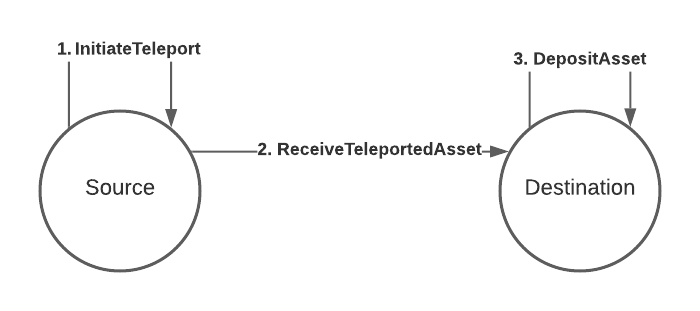Asset teleportation
Asset teleportation is the simpler method of the two for sending assets from one chain to another. It has only two actors, the source and the destination.
Process

The way in which we transfer assets between the source and the destination are briefly summarized in the numbered labels on the diagram, and are explained in more detail below:
1. InitiateTeleport
The source gathers the assets to be teleported from the sending account and takes them out of the circulating supply, taking note of the total amount of assets that were taken out.
2. ReceiveTeleportedAssets
The source then creates an XCM instruction called ReceiveTeleportedAssets and puts the amount of assets taken out of circulation and the receiving account as parameters to this instruction.
It then sends this instruction over to the destination, where it gets processed and new assets are put back into the circulating supply accordingly.
3. DepositAsset
The destination then deposits the assets to the receiving account of the asset.
Thoughts
The phrases "taken out of circulating supply" and "put back into circulating supply" are highlighted above to give an indication of how much flexibility an XCM executor has in implementing the semantics of taking an asset out of and putting it back into its circulating supply. The straightforward answer is to burn the assets to take them out of circulation, but there are multiple methods of achieving the same goal, such as transferring the assets locally to an inaccessible account. Likewise for putting assets back to circulation, the receiving consensus system can freely choose to implement such semantics by releasing assets from a pre-filled and inaccessible treasury of the assets transferred, or perform a mint of the assets.
The above also gives a hint on the disadvantages of this model, it requires both the source and destination to have a high level of mutual trust. The destination must trust that the source has appropriately removed the assets that were sent over from the circulating supply, and the source must also trust the destination to put the assets back into circulation. An asset teleportation should result in the same circulating supply of the asset. Failing to uphold either of these two conditions will result in a change in the asset's total issuance (in the case of fungible tokens) or a complete loss/duplication of an NFT.
Example
The following is an example XCM program that achieves the process described above.
let message = Xcm(vec![
WithdrawAsset((Here, teleport_amount).into()),
InitiateTeleport {
assets: All.into(),
dest: Parachain(1).into(),
xcm: Xcm(vec![DepositAsset {
assets: All.into(),
beneficiary: Junction::AccountId32 {
network: None,
id: ALICE.into(),
}
}]),
},
]);
Let's discuss how the new instructions work.
InitiateTeleport
InitiateTeleport { assets: MultiAssetFilter, dest: MultiLocation, xcm: Xcm<()> }
This instruction is intended to be executed from the source system.
It takes the assets to be teleported (that match the MultiAssetFilter) from the holding register, which needs to have been populated, usually with a WithdrawAsset instruction.
It then sends an XCM to the destination system given by dest with the following instructions:
- ReceiveTeleportedAsset
- ClearOrigin
- All the instructions from the
xcmoperand, in this caseDepositAsset
As we see in the example, instructions 1. and 2. are always added by the executor, no need to specify them.
ReceiveTeleportedAsset
ReceiveTeleportedAssets(MultiAssets)
This instruction is a trusted indication. It should only be executed if the origin of the XCM is trusted for this purpose. This level of care must be taken because this instruction will put assets into the circulating supply, usually minting them. As specified earlier, this can result in an increase/decrease in circulating supply of an asset, or a duplication/loss of an NFT, if the source is not trusted for this purpose.
You can set which origins are allowed to act as teleporters by configuring the IsTeleporter type in the XCM executor.
If the origin is not allowed to teleport assets to this system, an UntrustedTeleportLocation error is returned.
This instruction will populate the holding register with the teleported assets, which can be used by further instructions.
In our example, the DepositAsset instruction will deposit these assets to the receiving account.
ClearOrigin
ClearOrigin
This instruction clears the origin register of the XCVM.
It's mainly used to not allow further instructions to act on behalf of the previous origin.
The InitiateTeleport instruction sends a XCM to the destination system with freshly minted assets and immediately clears the origin.
Another example
Let's say we want to teleport an NFT (Non-Fungible Token) this time, instead of a fungible token, to another system. We could do so with the following program:
let message = Xcm(vec![
WithdrawAsset((GeneralIndex(1), 42u32).into()),
InitiateTeleport {
assets: All.into(),
dest: Parachain(1).into(),
xcm: Xcm(vec![DepositAsset {
assets: All.into(),
beneficiary: Junction::AccountId32 {
id: ALICE.into(),
network: None,
}.into()
}]),
},
]);
Very little changes, in fact, only the MultiAsset we're referencing changes, like we would expect.
All the teleportation logic stays the same.
The example assumes an NFT with index 42 inside a collection with index 1.
Next steps
We'll look at reserve-backed transfers next.